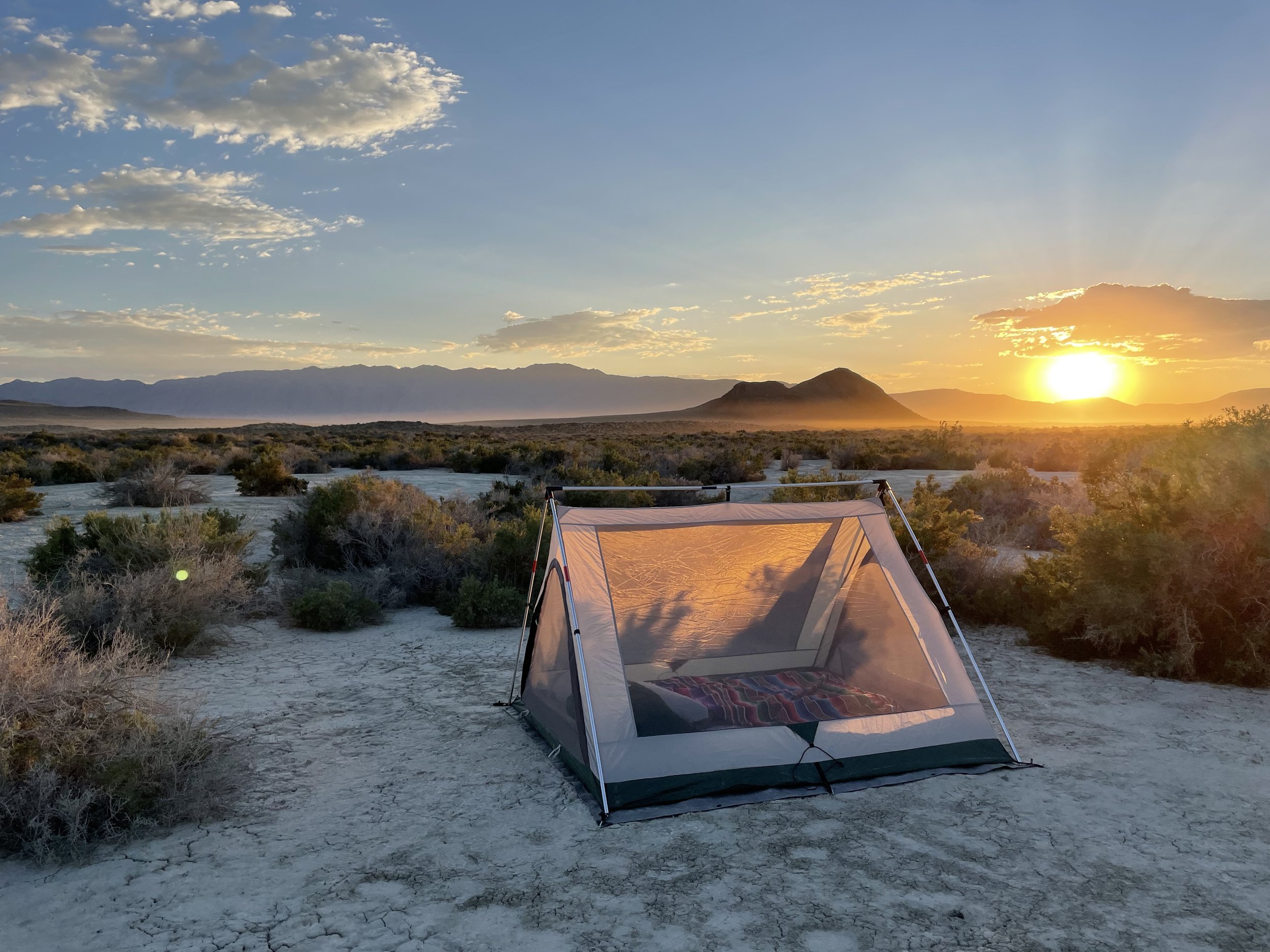
Camping in the NCA
Black Rock-High Rock country offers excellent opportunities for primitive camping, from car camping on the playa to off trail backpacking in the wilderness. Here’s what you need to know before you set up camp.
The major draw to this area are the wide open, wild spaces that provide breathtaking views and unlimited solitude. While most camping occurs in a dispersed fashion, there are a few areas with primitive camping facilities.
Guidelines and Rules for Camping in the NCA
At Soldier Meadows Springs and High Rock Canyon, camping is allowed only in designated campsites.
Camping at Stevens Camp and Massacre Ranch will be limited to designated sites in the future.
Vehicles are allowed to travel within 50 feet off of designated routes to camp. Use existing campsites where possible.
Do not camp within 300 feet of any open water.
Please respect wildlife and camp away from the fenced off Coyote Springs Dunes area on the playa.
Campfires on the playa and dunes must be contained or elevated to prevent scarring or burning of the playa surface.
Extinguish all fires before you leave.
In addition to the specific rules above, Friends of Black Rock-High Rock also strongly recommends observing the seven Leave No Trace principles:
Plan ahead and prepare
Travel and camp on durable surfaces
Dispose of waste properly
Leave what you find
Minimize campfire impacts
Respect wildlife
Be considerate of other visitors
The NCA is a vast, remote landscape. Services are few and far between and visitors must be prepared to deal with emergency situations.
Remember to bring your own water, firewood, and shelter, as these items are not easily found or reliable throughout the year.
Nevada is currently experiencing an extreme to severe drought and it is recommended to limit fires to fire pans or designated fire rings.
More important information to know before you go »
Dispersed Camping
Most campers find random locations without any camping facilities which provide ample opportunities for solitude.
There are many dispersed campsites located along the western edge of the Black Rock Desert playa in the “bays” and other nooks located just off the edge of the playa.
Many campers enjoy camping in the middle of the playa, which offers a unique experience of being one small part of a magnificent, immense planet.
Other dispersed campsites are established near the ends of the cherry stem routes that lead into some of the Wilderness Areas, in the vicinity of several hot springs (Trego, Black Rock and Double Hot), and along roads throughout the NCA.
Several primitive campsites have also been established at Cassidy Mine and Flowing Wells, which are located on the western fringe of the playa, between the playa and Soldier Meadows Road.
Remember: The best campsites are found, not made. Use existing campsites where possible to prevent unnecessary impacts to the desert resources.
Soldier Meadows
Semi-primitive camping facilities are located within the Soldier Meadows Hot Spring Area of Critical Environmental Concern (ACEC). Facilities in this area include primitive campsites (parking areas and fire pits), a vault toilet, a primitive cabin, and walking trails that lead to the hot springs.
There are seven defined campsites in the ACEC. Five are located in the Hot Creek Campground, one is at the Cabin Site, and the last is located above the Hidden Spring to the west of the main hot springs area. The primitive cabin is available for public use on a first-come first-served basis.
Soldier Meadows Ranch also allows camping on their property with permission and a small fee. They also provide lodging and meals.
Note that Soldier Meadows is one of the most highly visited areas in the NCA. If you are looking for solitude, this may not be your place.
Stevens Camp
Stevens Camp is a popular camping area located at the north end of High Rock Canyon.
It is a convenient and accessible camping area that provides a good base camp for exploration of High Rock Canyon and the surrounding uplands – rich in game and not many people.
There are four established camping areas at Stevens Camp, including a large site near the free use cabin. These sites include amenities such as a vault toilet, picnic tables, fire pits and a grill.
The cabin itself is available for public use on a first-come first-served basis and includes amenities such as running water (must be treated prior to drinking), a wood stove, a shower and hot water heater, and connections for a generator to provide power and lights to the cabin.
The cabin is full most of the summer, so don’t expect to be the only person looking to use the facilities.
High Rock Canyon
High Rock Canyon is a popular camping area for the adventurous types who have 4WD and know how to use it.
There are no camping facilities at the campsite in High Rock Canyon, but there is an abundance of solitude and interesting side canyons to explore.
To prevent impacts to bighorn sheep and raptor nesting, camping is limited to designated sites in High Rock Canyon. The road through High Rock Canyon is closed from February 1st until the second weekend in May each year.
The Lahontan Cutthroat Trout Wilderness Study Area
This area encompasses a healthy and productive watershed that was established as a Wilderness Study Area (WSA) to protect the last unaltered population of Lahontan Cutthroat Trout.
The canyon from the north slope of the Black Rock Range provides excellent habitat for deer, antelope, bighorn sheep and wild horses. The aspen-filled canyons and cool desert streams provide a welcome escape during the hot summer season.
Primitive campsites are scattered throughout the area along the stream and roads. There are no facilities at these campsites. Fishing is prohibited in the streams and Summit Lake.

